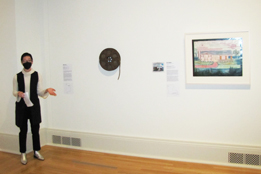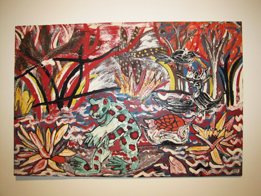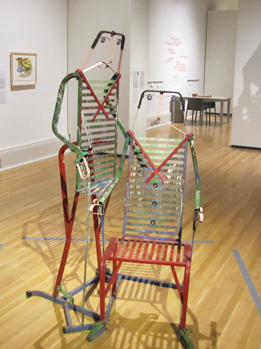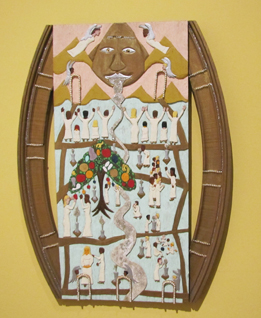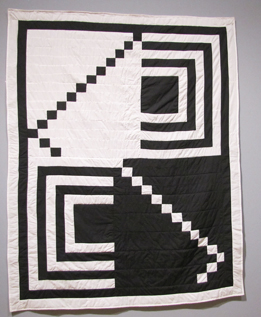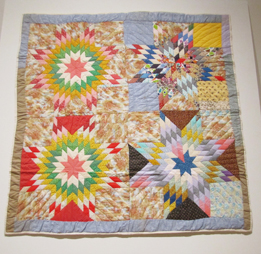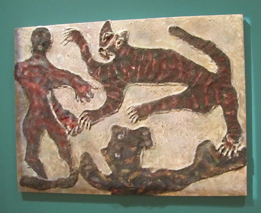
Sojourner’s Truth Staff
“My art is the evidence of my freedom. People have fought for freedom all over the world. I try to show that struggle. It is a war to be fought. We’re trying to win it.” – Thornton Dial
Thornton Dial, patriarch of a family of artists, whose work is included among the exhibition of African American art on display now at the Toledo Museum of Art, wrote that in explanation of one of the forces that propelled him as an artist.
Some of Dial’s pieces, including his seminal “Trip to the Mountaintop” are part of the collection obtained from the Souls Grown Deep Foundation, a collection titled Living Legacies: Art of the African American South.
The Museum has obtained 24 works over the last two years from the Souls Grown Deep Foundation, a vitally important organization which supports the work of African American artists in the southern United States. The Living Legacies collection debuted on Friday, January 14 and will continue until May 1.
Artists included in the exhibition are the Dial family: Thornton and his two sons Thornton, Jr and Richard Dial. Included in the collection are the works of Leroy Almon, Lonnie Holley, Ronald Lockett, Joe Minter, John B. Murray, Royal Robertson, Georgia Speller, Henry Speller, Luster Willis along with several generations of women quiltmakers: Louisiana Bendolph, Mary Elizabeth Kennedy, Jessie T. Pettway, Lola Pettway, Lucy T. Pettway, Martha Pettway, Rita Mae Pettway and Florine Smith, as well as Estelle Witherspoon, one of the founders of the Freedom Quilting Bee.
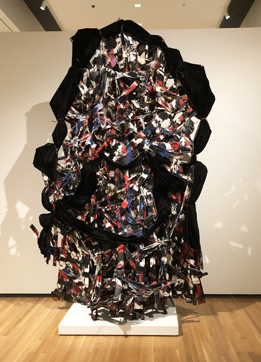
Thornton Dial’s large-scale “Trip to the Mountaintop” is an homage to Dr. Martin Luther King, Jr’s last, famous speech in Memphis during which he exhorted his followers to try to make America a better place but cautioned that he might not be among them in their continued struggle.
Dial’s sculpture is a combination of wood, metal, clothing, rope, wire and steel symbolizing the long arduous trek up a mountainside. His epic work is the culmination of a variety of pieces by the southern-based Blas artists.
“Living Legacies celebrates the multiplicity, power and complexity of these artists’ practices that represent a crucial part of the American experience and art historical record,” said Jessica Hong, TMA’s curator of modern and contemporary art. “The exhibition is intended to illuminate these visionaries’ multifaceted creative achievements and enduring legacies.”
The Souls Grown Deep Foundation began its ongoing program in 2014 in order to transfer works to the permanent collections of leading American and international art museums. One of the typical ways in which artists from the Foundation and in the Living Legacies collection express themselves is through the use of everyday objects in their art.
Lonnie Holley, for example, has used discarded materials such as old car parts, truck gears, electrical cords and recycled pieces of communication technology to critique societal wrong from racial injustice, to child neglect, to environmental destruction.
Lockett (The Verge of Extinction, 1994) and Minter (How Do I Look?, 1997) also express themselves through metal assemblages.
The use of everyday objects is especially present in the collection of quilts in the exhibit.
A variety of patterned quilts by Bendolph, Kennedy, the Pettways and other artists from Alabama – particularly Boykin, Alabama (known also as Gee’s Bend) – “frequently embody religious references or significant designs and … expanding the histories and legacies of quiltmaking in America,” notes the press release about the exhibit.
Much of the art in the exhibit dates back to and reflects the Civil Rights Movement of the 1950s and 1960s. Many were active during the period and Thornton Dial’s “Mountaintop” piece is especially poignant because he was an associate of Dr. King.
The exhibition includes a reading area with resources and materials reflecting the artists’ work and themes to allow visitors to reflect and comment.
Souls Grown Deep’s mission is to advocate for the inclusion of Blac artists from the South in the canon of American art history and to also foster economic empowerment, racial and social justice and educational advancement in the communities that gave rise to these artists.
The Living Legacies exhibition is in the TMA New Media Gallery until May 1. For general information, visitors can call 419-255-8000 or 800-644-6862 or visit toledomuseum.org.

